Our last three film specials, about the American production The Valentine Girl (J. Searle Dawley, 1917) with Marguerite Clark, the French Midinettes (René Hervil, Louis Mercanton, 1917) and Lorena (Georges Tréville, 1918), both starring Suzanne Grandais, were all based on series of Spanish postcards published by the Spanish company Chocolate Amatller Marca Luna. Today's post is also filled with Amattler postcards, but focuses on an Italian film with film diva Lyda Borelli, Carnevalesca (Amleto Palermi, 1918).

Spanish postcard by Amattler Marca Luna chocolate, series 7, no. 1. Photo: Lyda Borelli, Livio Pavanelli and Augusto Poggioli in Carnevalesca (Amleto Palermi, 1918). Here left of the marshall we see Livio Pavanelli and Augusto Poggioli, on the back in the flowery dress, Lyda Borelli, and right of her the unknown actor who plays Pietro.

Spanish postcard by Amattler Marca Luna chocolate, series 7, no. 2. Photo: Lyda Borelli in Carnevalesca (Amleto Palermi, 1918). Here Teresa (Borelli) and others watch the men doing a boat race. Carlo wins by cheating.

Spanish postcard by Amattler Marca Luna chocolate, series 7, no. 3. Photo: Lyda Borelli in Carnevalesca (Amleto Palermi, 1918).

Spanish postcard by Amattler Marca Luna chocolate, series 7, no. 4. Photo: Lyda Borelli in Carnevalesca (Amleto Palermi, 1918).
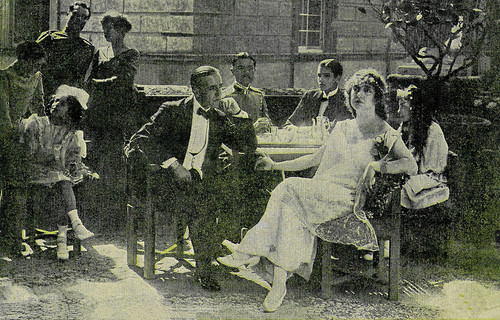
Spanish postcard by Amattler Marca Luna chocolate, series 7, no. 5. Photo: Lyda Borelli in Carnevalesca (Amleto Palermi, 1918).
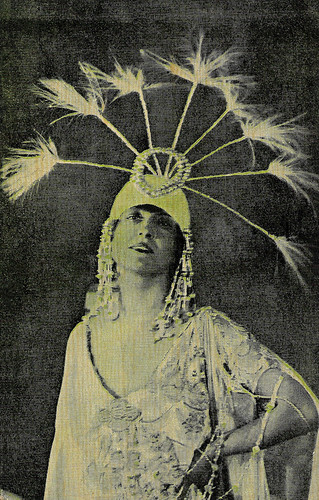
Spanish postcard by Amattler Marca Luna chocolate, series 7, no. 7. Photo: Lyda Borelli in Carnevalesca (Amleto Palermi, 1918).
The stars of Carnevalesca (Amleto Palermi 1918) are Lyda Borelli and Livio Pavanelli. Our sources are unclear about the other actors, and they also mixed up names. By viewing the film, we recognised Augusto Poggioli as Prince Luciano and Thea as Ms Thea, but we were not able to trace the actor who plays Pietro. It is for sure not Alberto Capozzi as some sources pretend.
Carnevalesca was based on a script by Lucio d'Ambra. Photography was by Giovanni Grimaldi. It's told around four carnivals, that take place at the castle of Malazia. The first white carnival shows the young children of the sovereign and their little cousins, who enjoy themselves with merry games.
With the help of a detective, the Court Marshall of the old King Luigi of Malazia discovers that the king's son, Luciano (Augusto Poggioli), heir to the throne, has an affair with young Ms Thea (the actress Thea); she is pregnant. After threats by the Marshall, Luciano sacrifices the throne in order not to dishonour and abandon his mistress and flees with her.
Who will be heir to the throne then? The blue carnival starts. At night, during a big ball, the king makes the first will in favour of his nephew Carlo (Livio Pavanelli), of whom we already know he is vile and evil, winning a boat race by cheating. The king rethinks and instead selects Luciano's sister, Maria Teresa (Lyda Borelli), with her fiance, Prince Pietro (actor unknown).
Spies spread the two versions of the will. At last, the king decides to postpone his decision, so a third option arises. Everybody is confused during the ball, because of this. Beforehand, Pietro has demonstrated his prestigious dagger, with which he once had to kill a scoundrel. An unknown person steals the dagger and kills the king with it.
The red carnival starts. According to the second will, Maria Teresa becomes queen, to Carlo's utmost jealousy. Luciano returns to the kingdom to avenge his father's death. Carlo more and more puts the suspicion on Pietro, right during the wedding day of Maria Teresa and Pietro. Vengeful, Maria Teresa fills Pietro with champagne, to confess his murder, but he only tells her he once killed a man with it. That's enough for her, so she stabs him to death.
Luciano, entering with Carlo, tells her she has made an atrocious mistake. She understands she has been misled by Carlo. Moreover, she presses him to confess the murder of her father. In shock, she leaves the castle and flees. It is the black carnival.
Scriptwriter/director Lucio d'Ambra remembered how Cines producer Baron Fassini, just like he had drilled sailors when in the navy, now drilled his crew, but treated his star Borelli with the highest regard. D'Ambra was commanded to write the script for Carnevalesca in ten days. He hoped to elevate the film by a score by Pietro Mascagni but nothing came of it, so the ordinary cinema music and Viennese waltz accompanied it.
After the film came out, Giacomo Puccini enthusiastically came to him announcing they had to collaborate on it, but, again, nothing came of it. At the time the journal Vita cinematografica considered the antinaturalistic, Symbolist film, not only because of its decadent visuals but also for its erudite, Dannunzian intertitles, as too excessive and artificial, fearing that soon the American realism, backed by their endless funding, would wipe away the Italians. The journal also blamed D'Ambra for starting the real drama too late, during the red carnival.
In 1993 the film was restored by the Cineteca di Bologna. Clips from the film were used in the compilation film Diva dolorosa (1999) by Peter Delpeut.
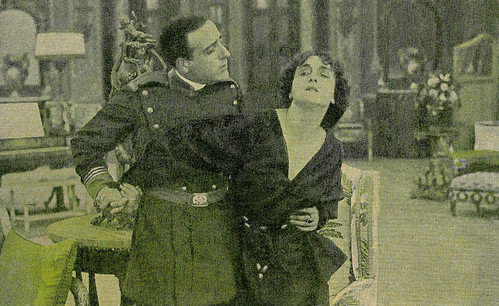
Spanish postcard by Amattler Marca Luna chocolate, series 7, no. 8. Photo: Lyda Borelli in Carnevalesca (Amleto Palermi, 1918).

Spanish postcard by Amattler Marca Luna chocolate, series 7, no. 9 (17a). Photo: Livio Pavanelli and Lyda Borelli in Carnevalesca (Amleto Palermi, 1918). Here Teresa (Borelli) discovers that Carlo (Pavanelli) has misled her into thinking her husband killed her father. Carlo killed him instead.

Spanish postcard by Amattler Marca Luna chocolate, series 7, no. 11. Photo: Lyda Borelli in Carnevalesca (Amleto Palermi, 1918). Here Teresa (Borelli) suspects her husband has killed her father, as his dagger has been used.

Spanish postcard by Amattler Marca Luna chocolate, series 7, no. 12. Photo: Livio Pavanelli (at left) and Lyda Borelli in Carnevalesca (Amleto Palermi, 1918). Here Carlo (Pavanelli) fills the ears of Maria Teresa (Borelli) with false accusations.
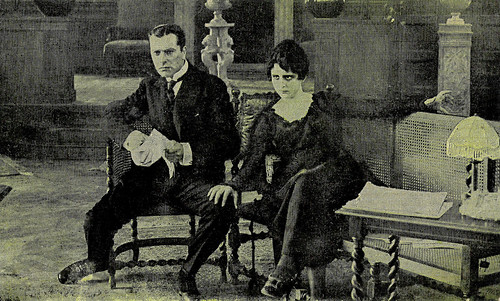
Spanish postcard by Amattler Marca Luna chocolate, series 7, no. 13. Carnevalesca (Amleto Palermi 1918). Photo: Livio Pavanelli and possibly Olga Benetti in Carnevalesca (Amleto Palermi, 1918). Their characters have just heard they will probably not inherit the throne.

Spanish postcard by Amattler Marca Luna chocolate, series 7, no. 14. Photo: Livio Pavanelli (at left) and Lyda Borelli in Carnevalesca (Amleto Palermi, 1918).

Spanish postcard by Amattler Marca Luna chocolate, series 7, no. 15. Photo: Lyda Borelli in Carnevalesca (Amleto Palermi, 1918).

Spanish postcard by Amattler Marca Luna chocolate, series 7, no. 16. Photo: Livio Pavanelli and Lyda Borelli in Carnevalesca (Amleto Palermi, 1918). Carlo abhors when he discovers the poisonous lies Maria Teresa made killing her husband, Prince Pietro.
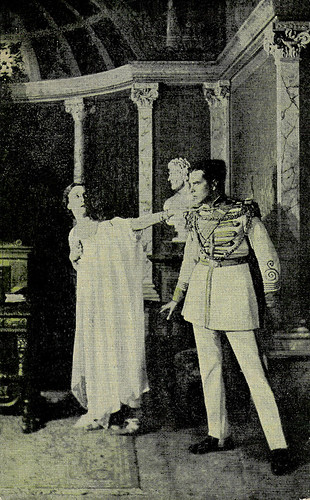
Spanish postcard by Amattler Marca Luna chocolate, series 7, no. 17. Photo: Lyda Borelli and Livio Pavanelli in Carnevalesca (Amleto Palermi, 1918). Teresa (Borelli) realises she has killed her husband unjustly, as Carlo was the culprit and he put the blame on the husband.

Spanish postcard by Amattler Marca Luna chocolate, series 7, no. 18. Photo: Lyda Borelli in Carnevalesca (Amleto Palermi, 1918). Maria Teresa discovers she has killed the man she loved while was innocent. Just as with the dead Scarpia in Puccini's opera 'Tosca' and the preceding play by Sardou with Sarah Bernhardt performing, candles are placed next to the dead person.

Spanish postcard by Amattler Marca Luna chocolate, series 7, no. 19. Photo: Lyda Borelli in Carnevalesca (Amleto Palermi, 1918).
Sources: Sempre in penombra (Italian), Wikipedia (Italian) and IMDb.

Spanish postcard by Amattler Marca Luna chocolate, series 7, no. 1. Photo: Lyda Borelli, Livio Pavanelli and Augusto Poggioli in Carnevalesca (Amleto Palermi, 1918). Here left of the marshall we see Livio Pavanelli and Augusto Poggioli, on the back in the flowery dress, Lyda Borelli, and right of her the unknown actor who plays Pietro.

Spanish postcard by Amattler Marca Luna chocolate, series 7, no. 2. Photo: Lyda Borelli in Carnevalesca (Amleto Palermi, 1918). Here Teresa (Borelli) and others watch the men doing a boat race. Carlo wins by cheating.

Spanish postcard by Amattler Marca Luna chocolate, series 7, no. 3. Photo: Lyda Borelli in Carnevalesca (Amleto Palermi, 1918).

Spanish postcard by Amattler Marca Luna chocolate, series 7, no. 4. Photo: Lyda Borelli in Carnevalesca (Amleto Palermi, 1918).

Spanish postcard by Amattler Marca Luna chocolate, series 7, no. 5. Photo: Lyda Borelli in Carnevalesca (Amleto Palermi, 1918).

Spanish postcard by Amattler Marca Luna chocolate, series 7, no. 7. Photo: Lyda Borelli in Carnevalesca (Amleto Palermi, 1918).
Four carnivals
The stars of Carnevalesca (Amleto Palermi 1918) are Lyda Borelli and Livio Pavanelli. Our sources are unclear about the other actors, and they also mixed up names. By viewing the film, we recognised Augusto Poggioli as Prince Luciano and Thea as Ms Thea, but we were not able to trace the actor who plays Pietro. It is for sure not Alberto Capozzi as some sources pretend.
Carnevalesca was based on a script by Lucio d'Ambra. Photography was by Giovanni Grimaldi. It's told around four carnivals, that take place at the castle of Malazia. The first white carnival shows the young children of the sovereign and their little cousins, who enjoy themselves with merry games.
With the help of a detective, the Court Marshall of the old King Luigi of Malazia discovers that the king's son, Luciano (Augusto Poggioli), heir to the throne, has an affair with young Ms Thea (the actress Thea); she is pregnant. After threats by the Marshall, Luciano sacrifices the throne in order not to dishonour and abandon his mistress and flees with her.
Who will be heir to the throne then? The blue carnival starts. At night, during a big ball, the king makes the first will in favour of his nephew Carlo (Livio Pavanelli), of whom we already know he is vile and evil, winning a boat race by cheating. The king rethinks and instead selects Luciano's sister, Maria Teresa (Lyda Borelli), with her fiance, Prince Pietro (actor unknown).
Spies spread the two versions of the will. At last, the king decides to postpone his decision, so a third option arises. Everybody is confused during the ball, because of this. Beforehand, Pietro has demonstrated his prestigious dagger, with which he once had to kill a scoundrel. An unknown person steals the dagger and kills the king with it.
The red carnival starts. According to the second will, Maria Teresa becomes queen, to Carlo's utmost jealousy. Luciano returns to the kingdom to avenge his father's death. Carlo more and more puts the suspicion on Pietro, right during the wedding day of Maria Teresa and Pietro. Vengeful, Maria Teresa fills Pietro with champagne, to confess his murder, but he only tells her he once killed a man with it. That's enough for her, so she stabs him to death.
Luciano, entering with Carlo, tells her she has made an atrocious mistake. She understands she has been misled by Carlo. Moreover, she presses him to confess the murder of her father. In shock, she leaves the castle and flees. It is the black carnival.
Scriptwriter/director Lucio d'Ambra remembered how Cines producer Baron Fassini, just like he had drilled sailors when in the navy, now drilled his crew, but treated his star Borelli with the highest regard. D'Ambra was commanded to write the script for Carnevalesca in ten days. He hoped to elevate the film by a score by Pietro Mascagni but nothing came of it, so the ordinary cinema music and Viennese waltz accompanied it.
After the film came out, Giacomo Puccini enthusiastically came to him announcing they had to collaborate on it, but, again, nothing came of it. At the time the journal Vita cinematografica considered the antinaturalistic, Symbolist film, not only because of its decadent visuals but also for its erudite, Dannunzian intertitles, as too excessive and artificial, fearing that soon the American realism, backed by their endless funding, would wipe away the Italians. The journal also blamed D'Ambra for starting the real drama too late, during the red carnival.
In 1993 the film was restored by the Cineteca di Bologna. Clips from the film were used in the compilation film Diva dolorosa (1999) by Peter Delpeut.

Spanish postcard by Amattler Marca Luna chocolate, series 7, no. 8. Photo: Lyda Borelli in Carnevalesca (Amleto Palermi, 1918).

Spanish postcard by Amattler Marca Luna chocolate, series 7, no. 9 (17a). Photo: Livio Pavanelli and Lyda Borelli in Carnevalesca (Amleto Palermi, 1918). Here Teresa (Borelli) discovers that Carlo (Pavanelli) has misled her into thinking her husband killed her father. Carlo killed him instead.

Spanish postcard by Amattler Marca Luna chocolate, series 7, no. 11. Photo: Lyda Borelli in Carnevalesca (Amleto Palermi, 1918). Here Teresa (Borelli) suspects her husband has killed her father, as his dagger has been used.

Spanish postcard by Amattler Marca Luna chocolate, series 7, no. 12. Photo: Livio Pavanelli (at left) and Lyda Borelli in Carnevalesca (Amleto Palermi, 1918). Here Carlo (Pavanelli) fills the ears of Maria Teresa (Borelli) with false accusations.

Spanish postcard by Amattler Marca Luna chocolate, series 7, no. 13. Carnevalesca (Amleto Palermi 1918). Photo: Livio Pavanelli and possibly Olga Benetti in Carnevalesca (Amleto Palermi, 1918). Their characters have just heard they will probably not inherit the throne.

Spanish postcard by Amattler Marca Luna chocolate, series 7, no. 14. Photo: Livio Pavanelli (at left) and Lyda Borelli in Carnevalesca (Amleto Palermi, 1918).

Spanish postcard by Amattler Marca Luna chocolate, series 7, no. 15. Photo: Lyda Borelli in Carnevalesca (Amleto Palermi, 1918).

Spanish postcard by Amattler Marca Luna chocolate, series 7, no. 16. Photo: Livio Pavanelli and Lyda Borelli in Carnevalesca (Amleto Palermi, 1918). Carlo abhors when he discovers the poisonous lies Maria Teresa made killing her husband, Prince Pietro.

Spanish postcard by Amattler Marca Luna chocolate, series 7, no. 17. Photo: Lyda Borelli and Livio Pavanelli in Carnevalesca (Amleto Palermi, 1918). Teresa (Borelli) realises she has killed her husband unjustly, as Carlo was the culprit and he put the blame on the husband.

Spanish postcard by Amattler Marca Luna chocolate, series 7, no. 18. Photo: Lyda Borelli in Carnevalesca (Amleto Palermi, 1918). Maria Teresa discovers she has killed the man she loved while was innocent. Just as with the dead Scarpia in Puccini's opera 'Tosca' and the preceding play by Sardou with Sarah Bernhardt performing, candles are placed next to the dead person.

Spanish postcard by Amattler Marca Luna chocolate, series 7, no. 19. Photo: Lyda Borelli in Carnevalesca (Amleto Palermi, 1918).
Sources: Sempre in penombra (Italian), Wikipedia (Italian) and IMDb.
No comments:
Post a Comment